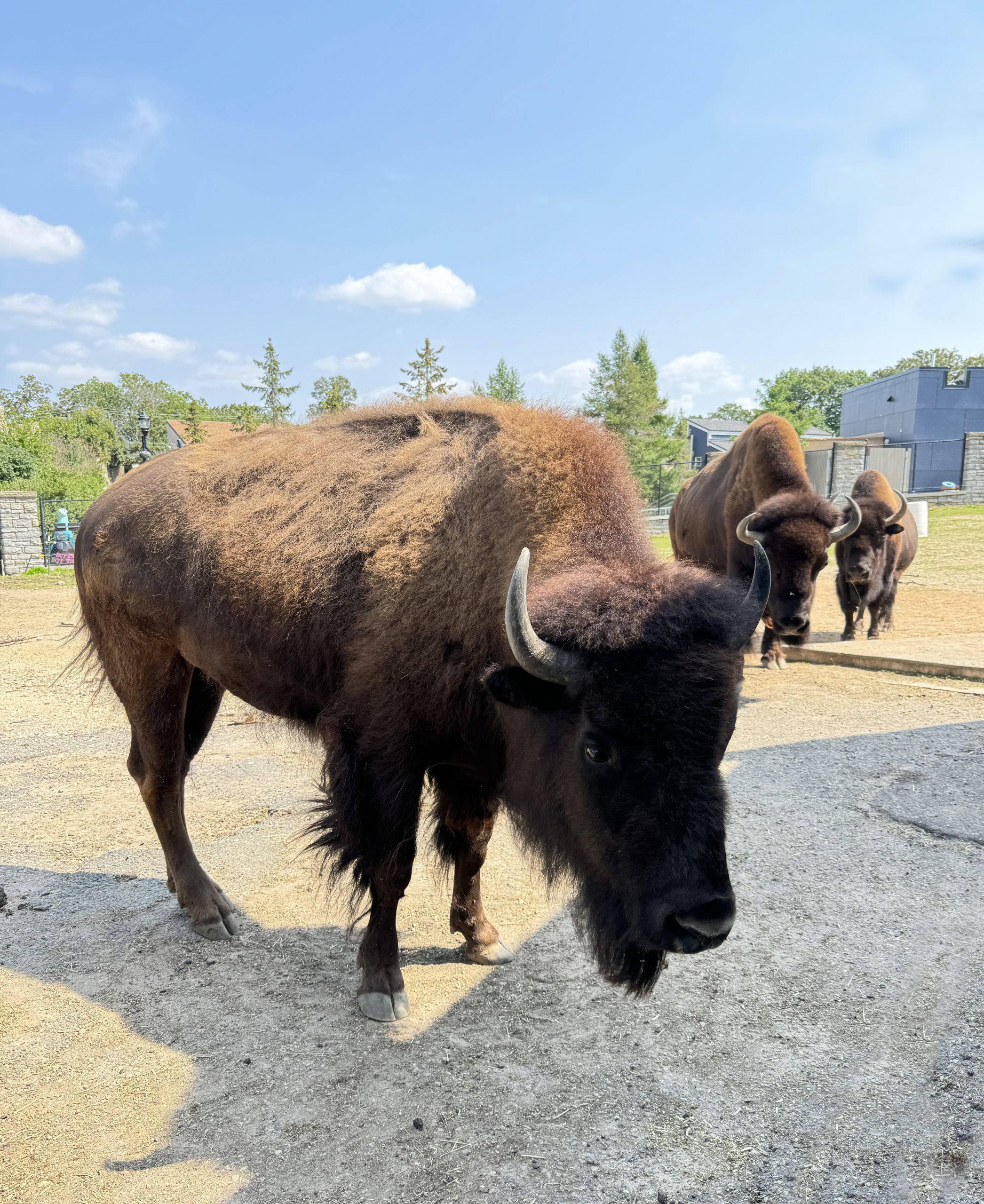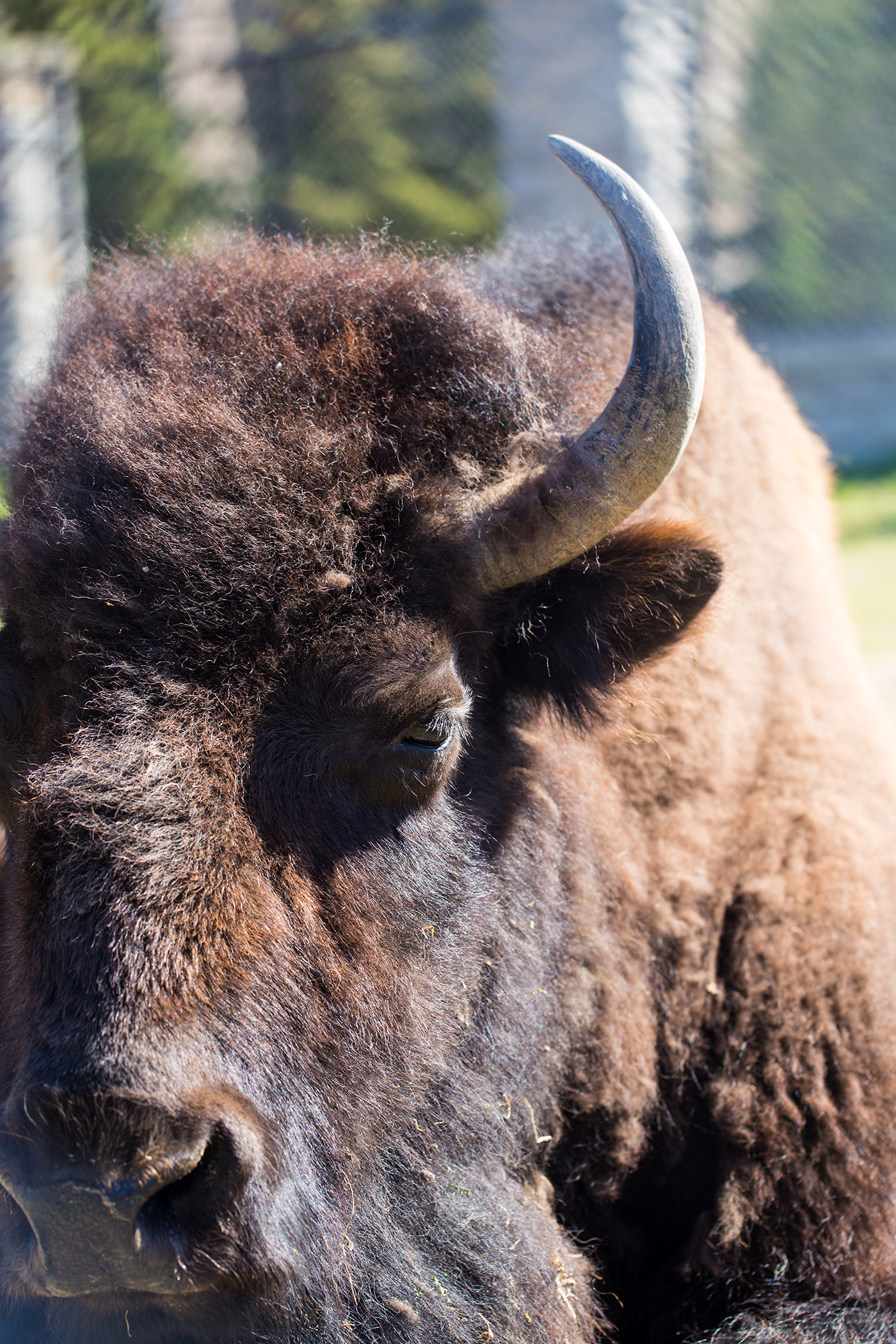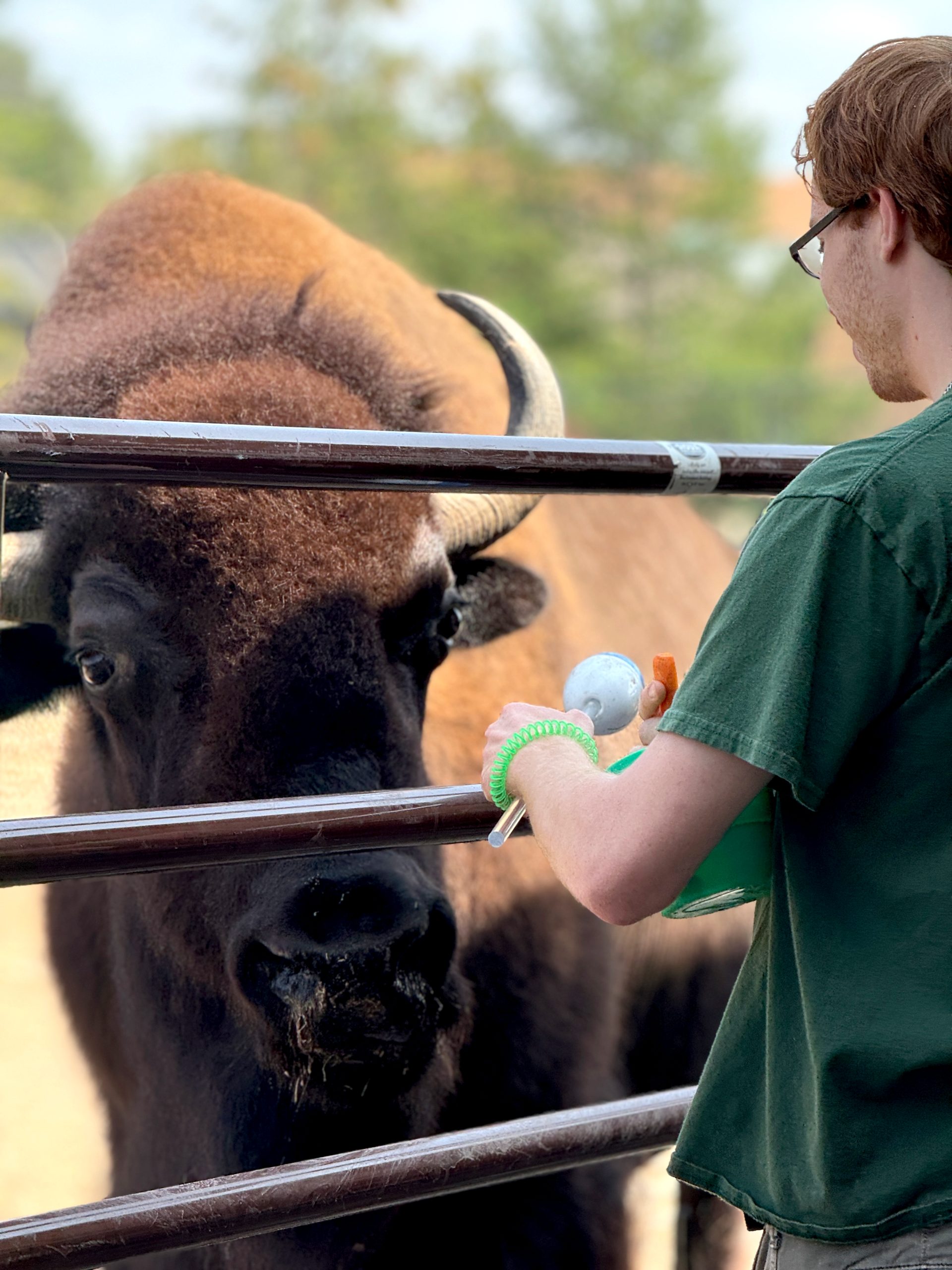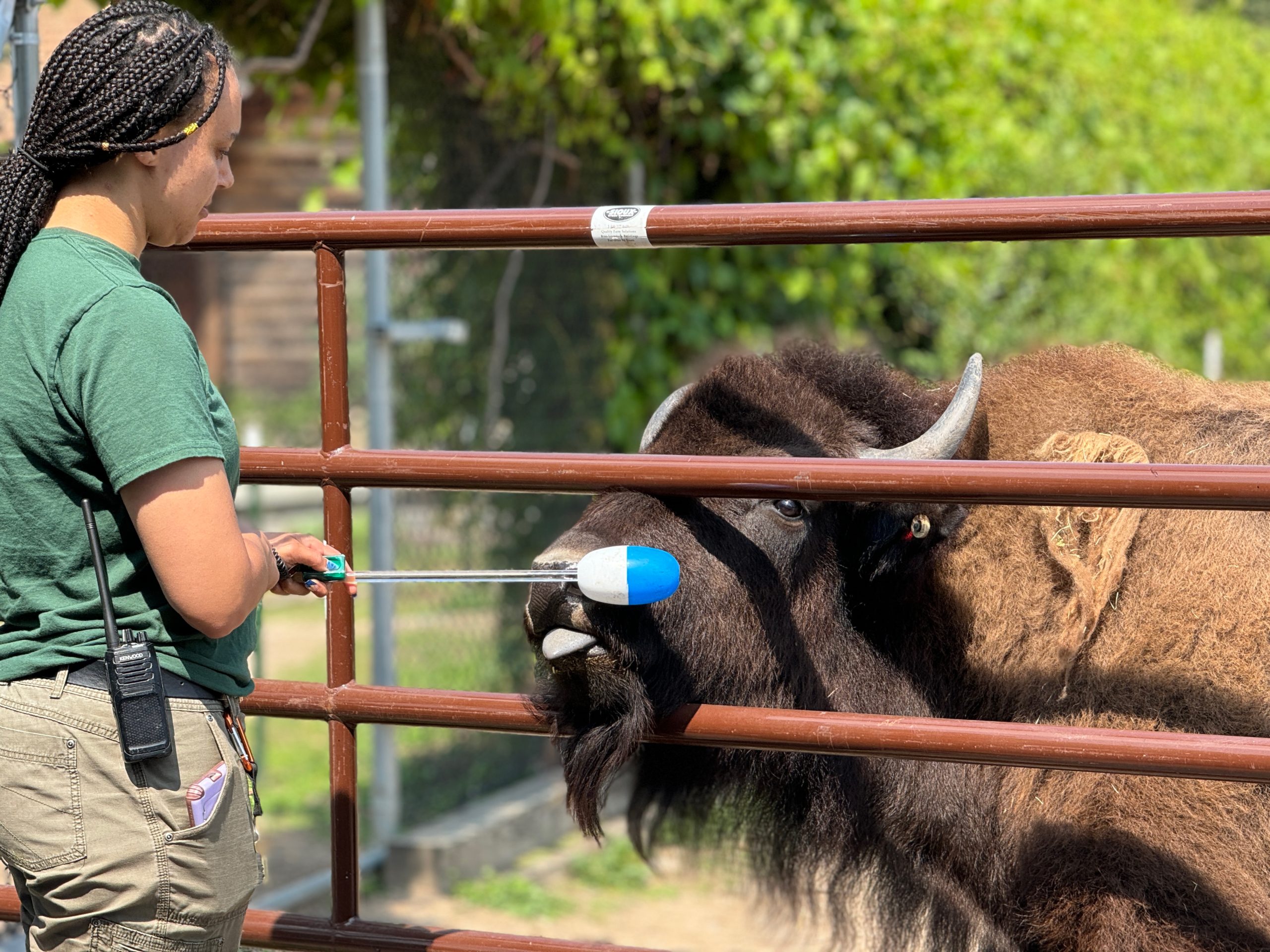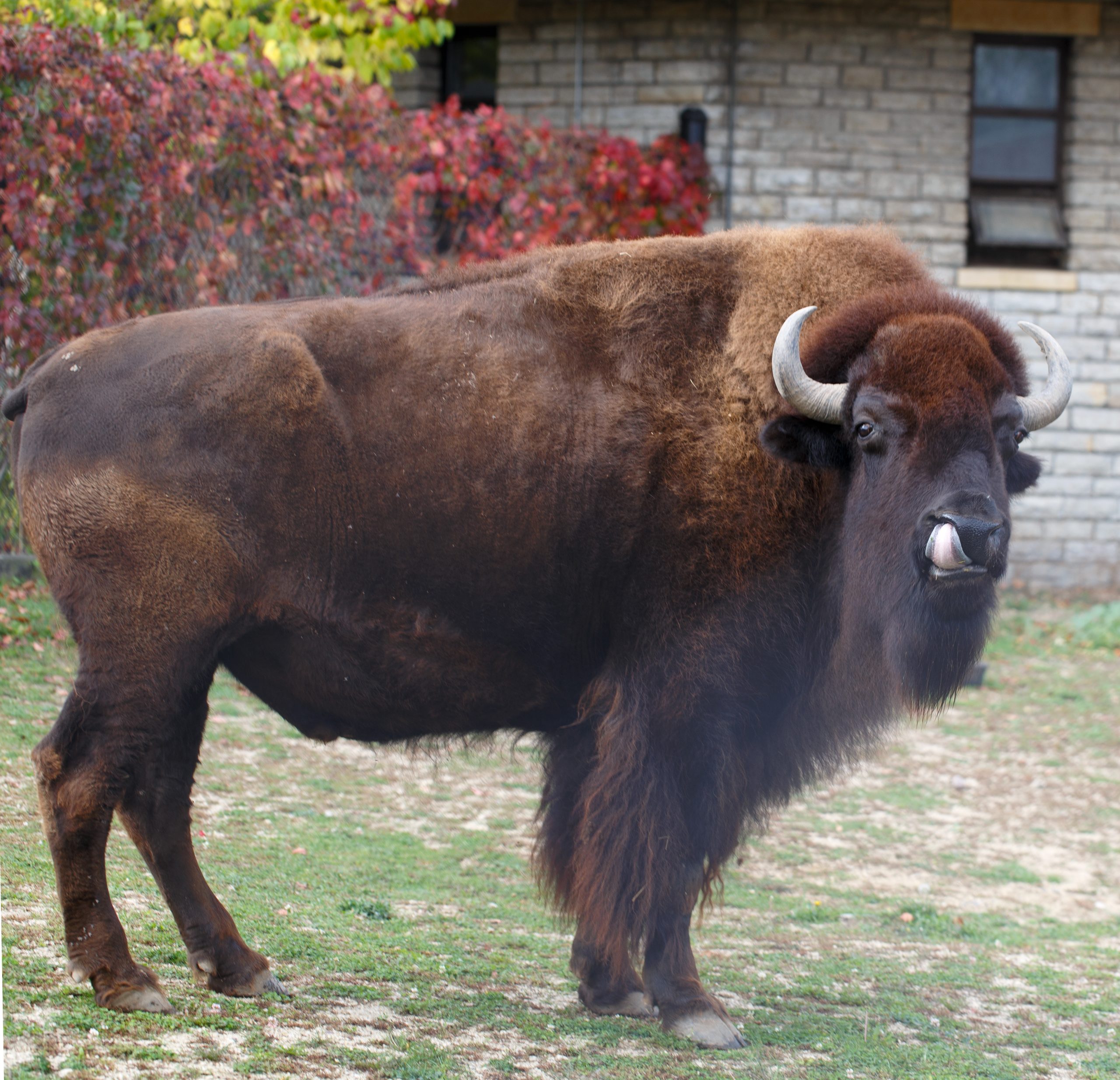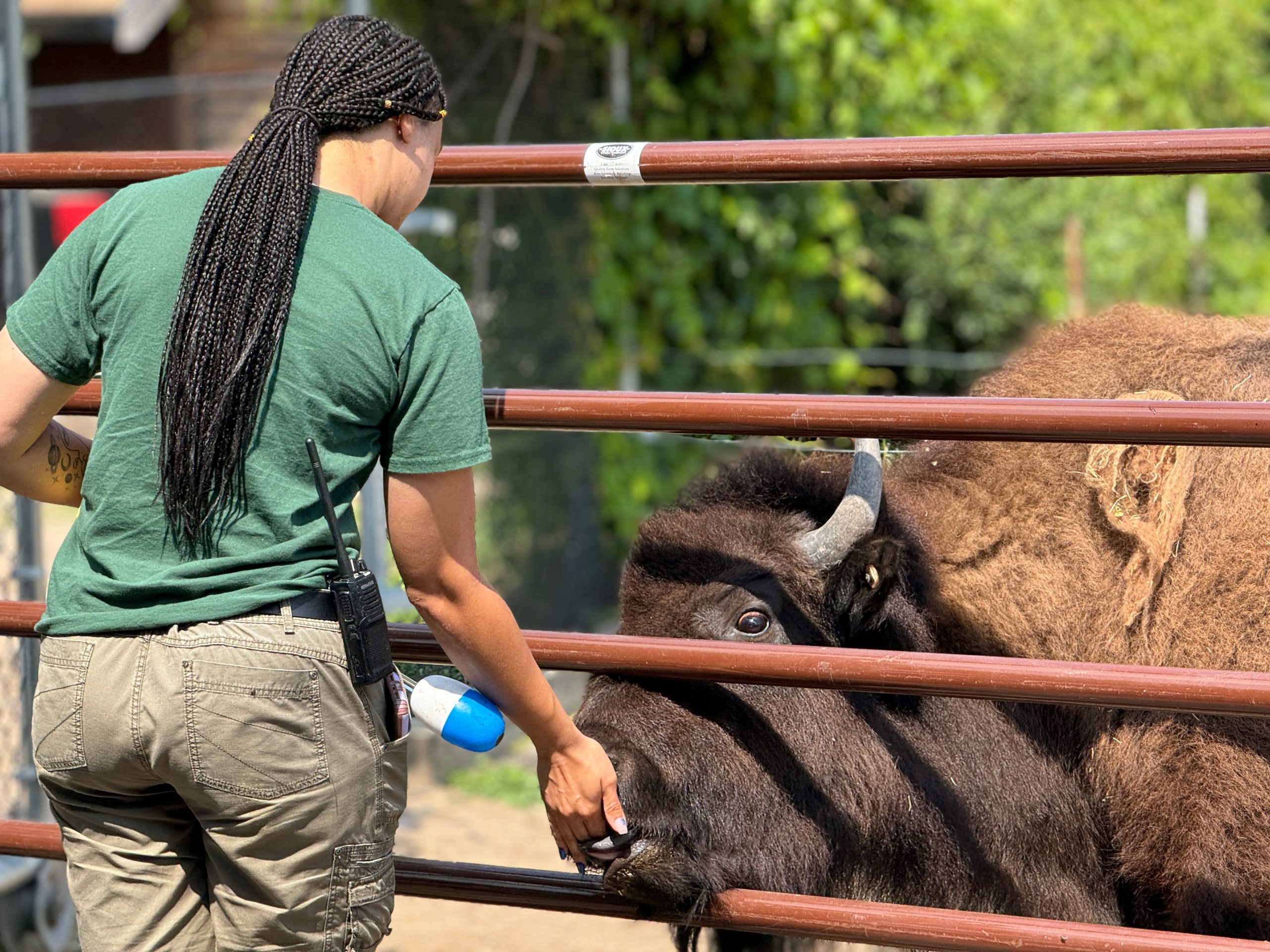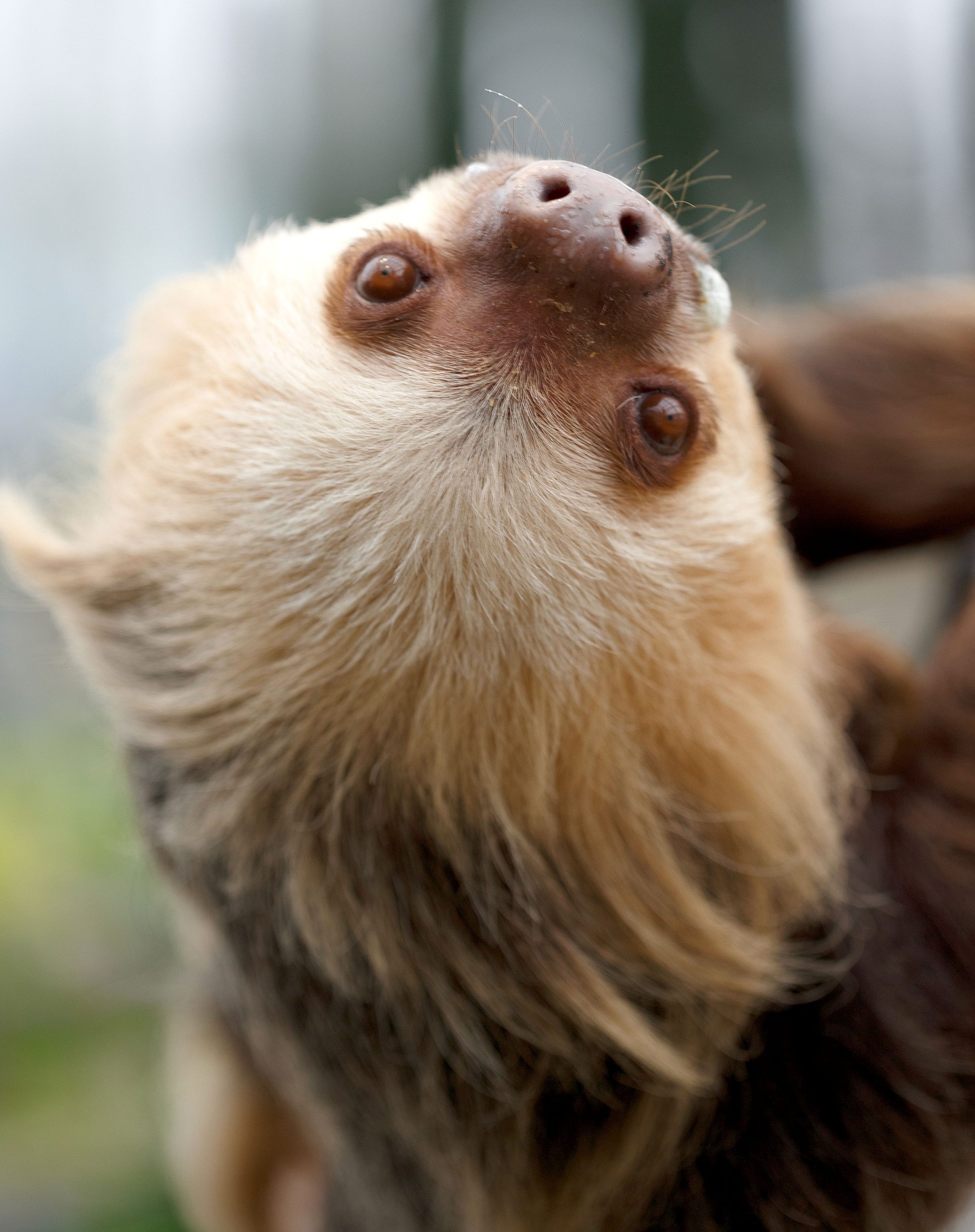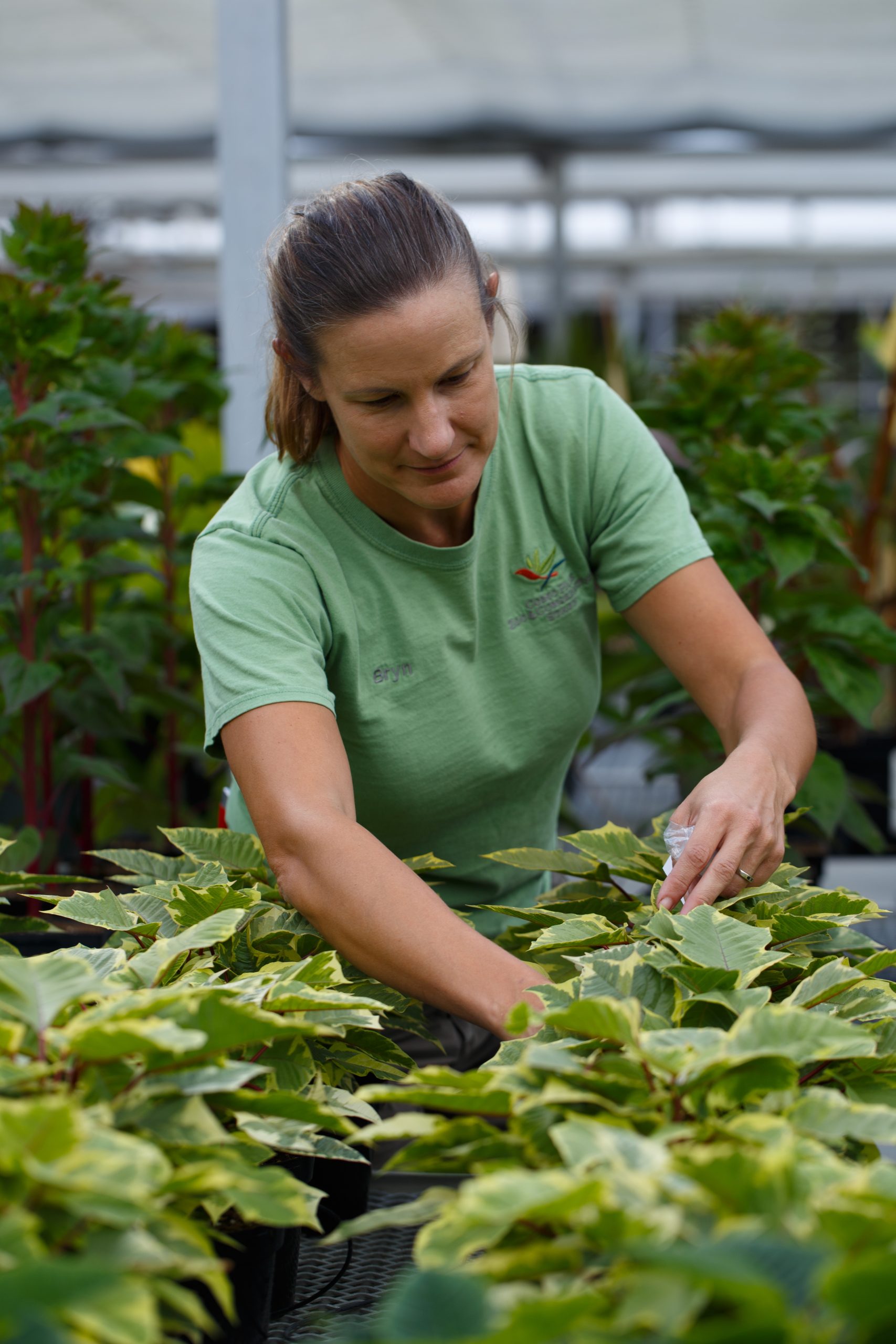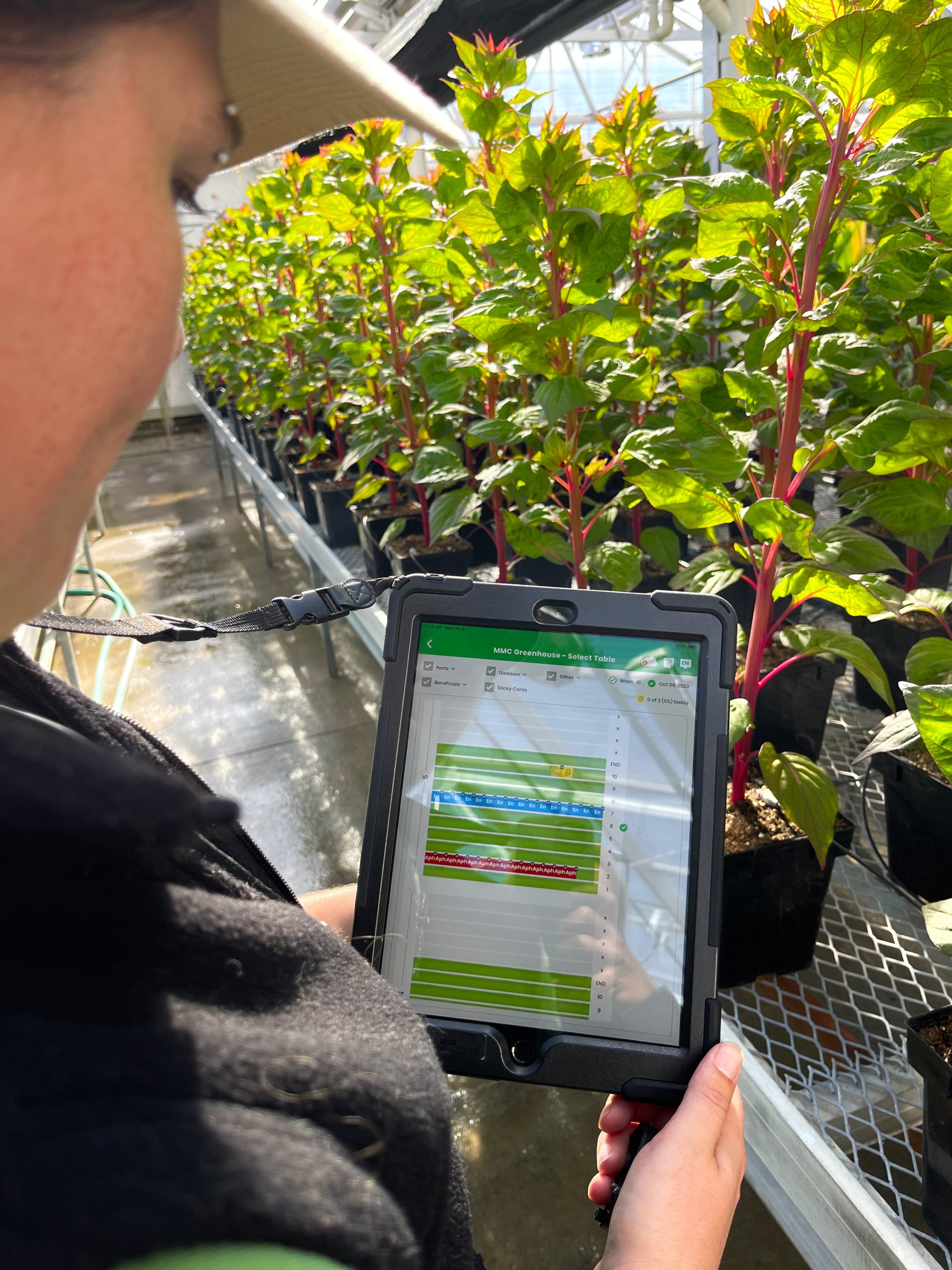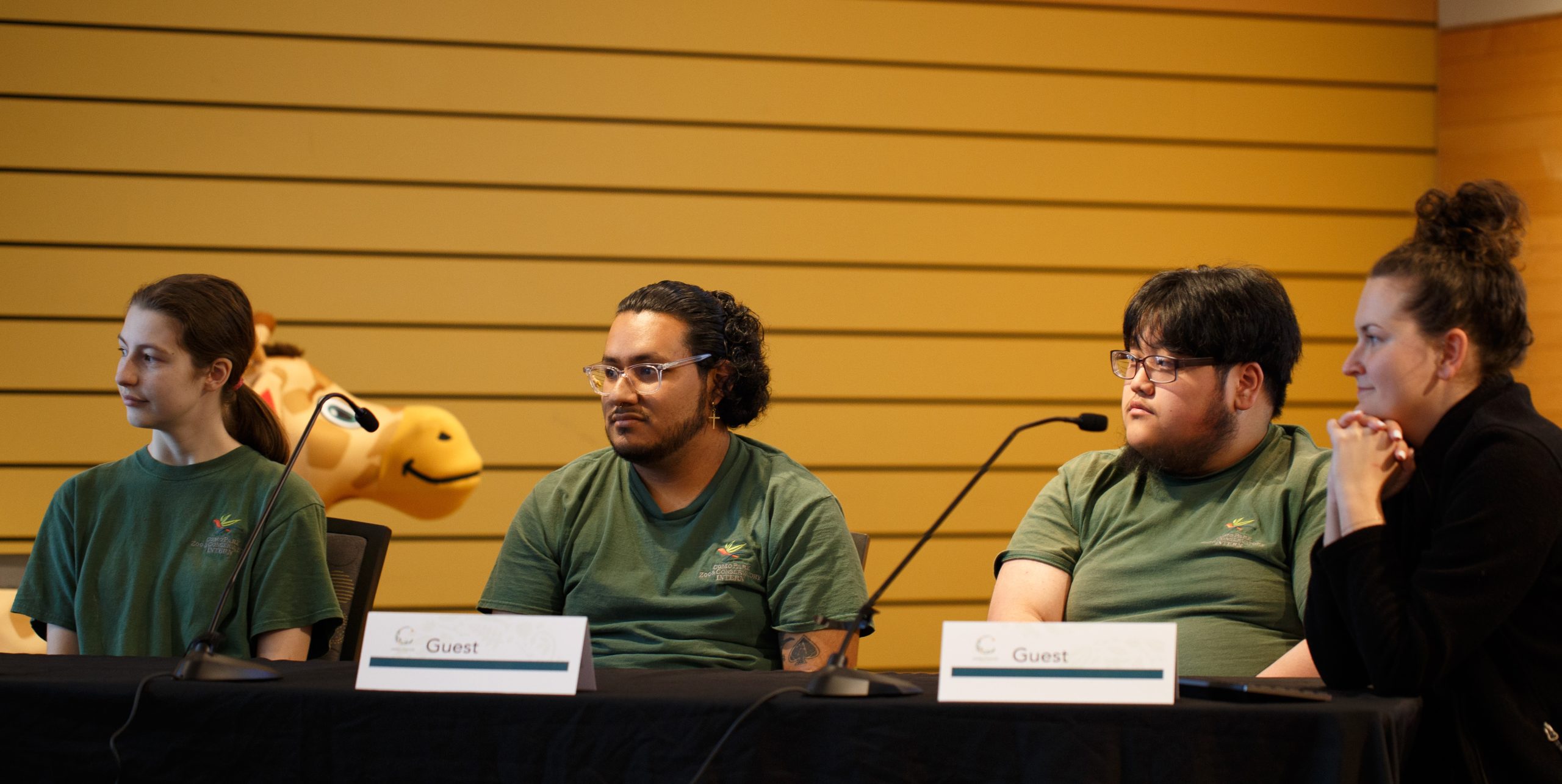Thanks to your support for Como Friends, a new generation is discovering career options in animal care and horticulture

For Como Zoo apprentice Sophia Dady, the trick is building trust with Ruby, the newest bison to live in Como’s historic barn. Over the course of the last year, Dady’s calm demeanor (and hundreds of carrots) have helped her to build a bond with the young bison, teaching her to follow a training target. This new husbandry skill now allows keepers to get a closer look at different parts of Ruby’s body, depending on where the target is positioned.
While few zoo interns ever get the chance to take on an important long-term project, animal training is all in a day’s work for Dady. A member of St. Paul’s Right Track apprentice program, Dady is one of 9 zookeeping and 4 horticultural apprentices at Como this year, earning 20- to 40-hours-a-week pay while they take on entry-level responsibilities throughout Como Zoo and the Marjorie McNeely Conservatory.
Though unpaid internships and volunteer conservation roles have often been the career path to jobs in animal care, the Right Track program helps to remove the economic barriers to participation for youth from cost-burdened households. “Right Track is designed to ensure that you don’t have to work without pay, or have multiple side jobs, to take advantage of a career-building opportunity,” says Lianna Sanders, the Como project manager who oversees the Right Track apprentices.


This year, Como has expanded the Right Track program to include horticultural apprentices like Willow Stephens, who recently had the opportunity to collaborate with horticulturist Rylee Werden on the design and installation of the Fall Flower Show. Hands-on experiences like that, and having the time it takes to dive into a potential career is another important part of the program, which also allows young people to attend college during their apprentice tenure.
Being fully immersed in animal care at Como has allowed Dady to take part in everything from primate training to observing behind-the-scenes veterinary care, while also attending Right Track professional development sessions in resume writing, financial literacy, and more. “Because the zookeepers see you more often, they trust you and allow you to take on your own projects, which is so important,” Dady says. “You’re given a bit more independence to find out what you like to do and what you’re good at, which is important as you’re developing your career.”
RightTrack apprentices earn a living wage while working in a variety of roles at Como. Additional funding from Como Friends helps apprentices purchase uniforms, heavy work boots, and other tools to be successful and safe on the job.
Great Late Breaking News: Como Zoo Right Track Apprentice Gabby Metzler (pictured below) was recently hired at the Fort Wayne Children’s Zoo as a marine mammal and aquarium zookeeper. And Sophia Dady has been hired as a temporary zookeeper at Como Zoo in the Tropical Encounters habitat as well as their small animal, reptile, and amphibian Animal Support Building.
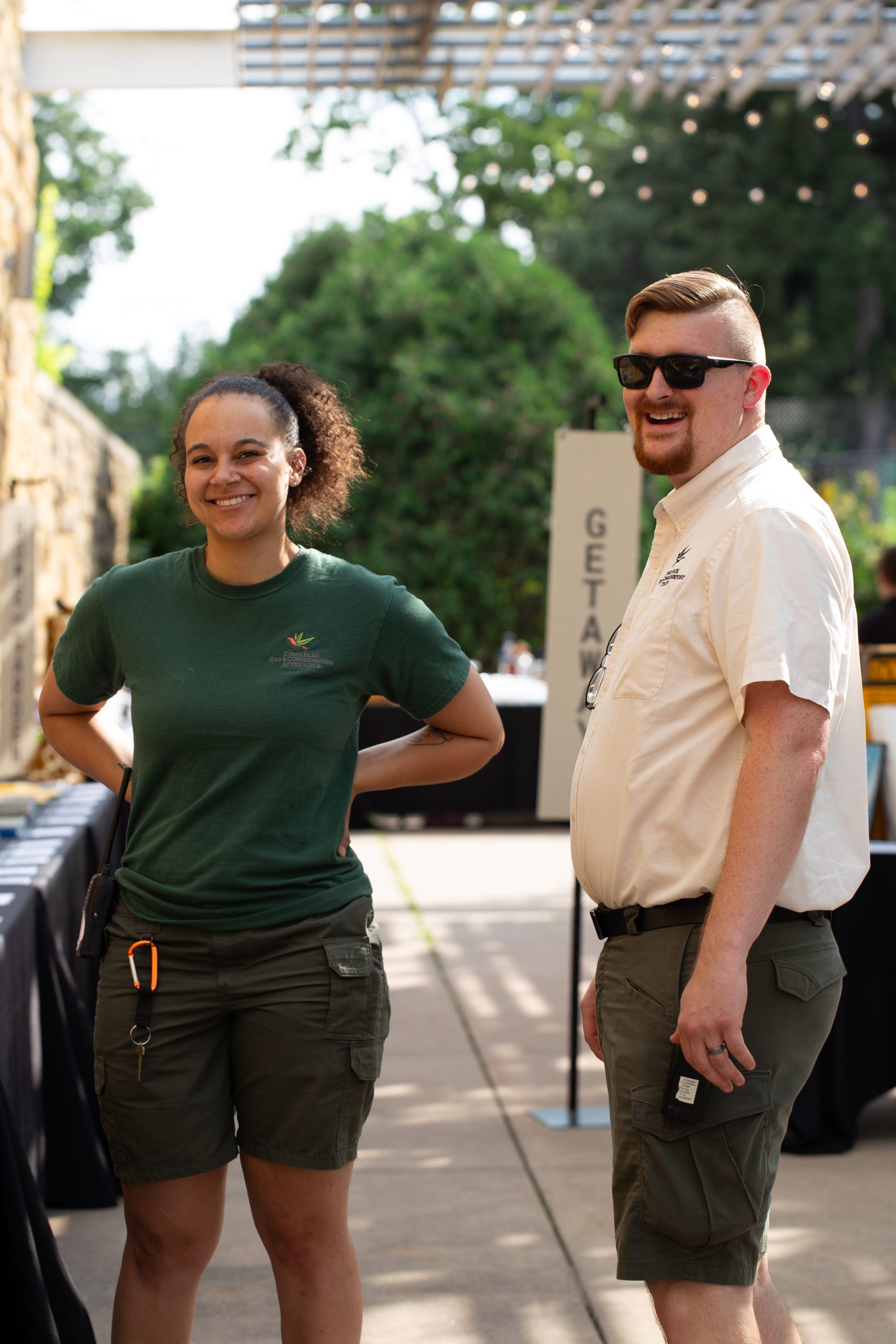
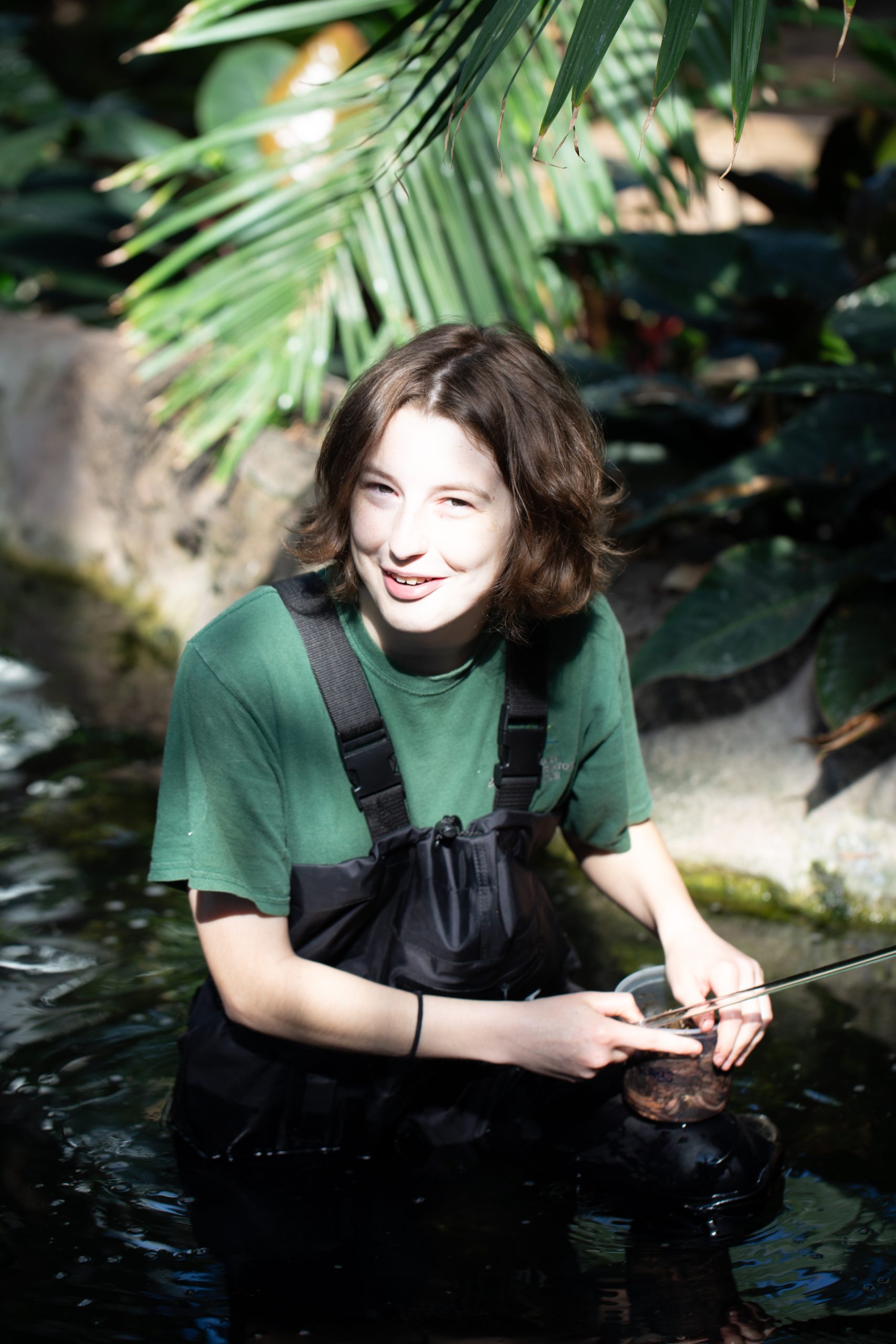
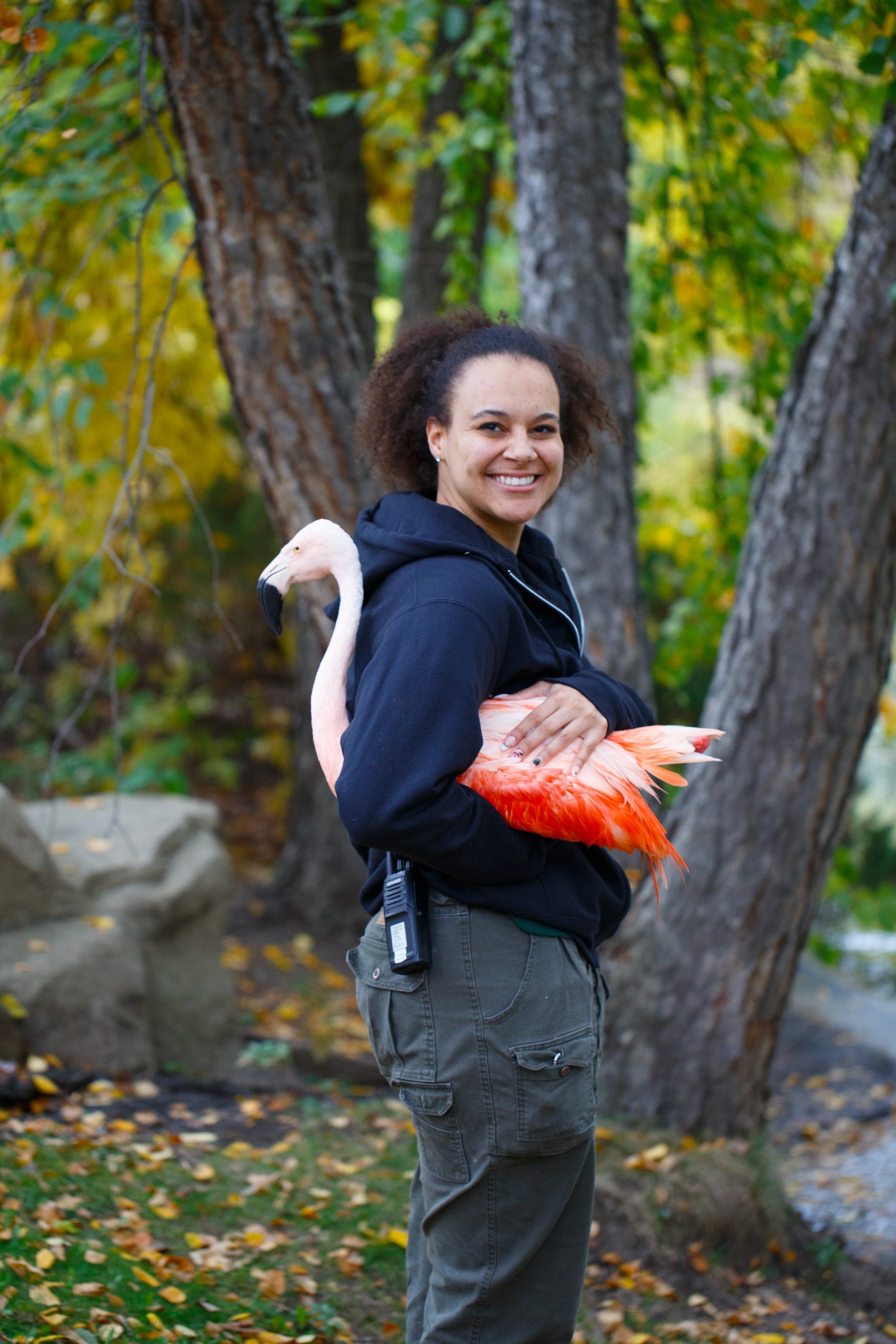
Personalizing nature is one of the first steps in protecting it
Sparky, Neil, Chloe, and Schroeder are just a few of the Como Park Zoo & Conservatory animals known to millions of visitors by their first names. Though there was once a time when zoos shied away from showcasing the individual animals in their care, a growing body of research now tells us that encouraging the public to forge personal connections to nature is one of the best ways to protect it.
That thinking is the driving force behind a series of new education and engagement strategies now in effect at Como Park Zoo & Conservatory, thanks to support from Advancing Conservation through Empathy (ACE) for Wildlife, a learning network of AZA-accredited zoos, aquariums, and other institutions exploring effective practices for fostering empathy for animals.
“The old theory was that simply sharing knowledge would be enough to inspire action, but what we’re coming to realize is that fostering meaningful emotional connections is just as important. Having empathy for an animal builds the desire to act on their behalf,” says Bekah Hanes, Como’s education and conservation curator. “Empathy is a skill you can develop and build on, and it’s becoming an important tool to help people cross the finish line from thinking about conservation to actually acting out those values, long after a zoo visit is over.”

The official shift toward empathy-focused engagement started in 2016, when Como Friends secured a major grant to help Como Park Zoo & Conservatory implement a new education and engagement strategy called the ROADMAP (Reaching Our Audiences by Developing Mission Aligned Programs). While the pandemic put a pause on public education programs for a time, Como continued to move ahead with its mission, securing grants from ACE for Wildlife to rewrite Como’s volunteer interpretive programs with an empathy focus, to use empathy as the lens for a new education strategic plan, and to create new permanent signage in the wolves and large cats habitat that uses empathy-inspiring language. While Como is one of the inaugural members of the ACE for Wildlife Learning Network, a special project of Seattle’s Woodland Park Zoo, the empathy movement is gaining ground with many other AZA-accredited zoos and aquariums.

Public Engagement Coordinator Kelsey Raffel says “it’s a great shift that’s happened in a relatively short amount of time,” in part because it embodies an approach toward audience engagement that Como’s keepers, horticulturists, interpreters, and educators gravitate toward naturally. “Focusing on empathy in our education programs, volunteer training, and visitor engagement has gotten a great reception from the campus,” she says. “For instance, our interpretive staff have shared that they love talking about the individual animals we care for, their personalities and likes and dislikes, and this approach really encourages them to do that.”
Jackie Sticha, president of Como Friends, says community support is critical to providing the resources Como Park Zoo & Conservatory needs to stay current as a conservation educator and a national leader in animal care. “More than 20 years ago, Como Friends funding helped Como Zoo make a shift toward positive reinforcement training for animals, and we see this empathy work as part of that same evolution,” she says. “It’s just natural to want to know the names of the animals at Como Zoo, and now the research tells us it’s also a really powerful way of connecting visitors to the natural world.”
With chrysanthemums playing the starring role in this season’s Fall Flower Show, it’s a guarantee that thrips will also be part of the cast.
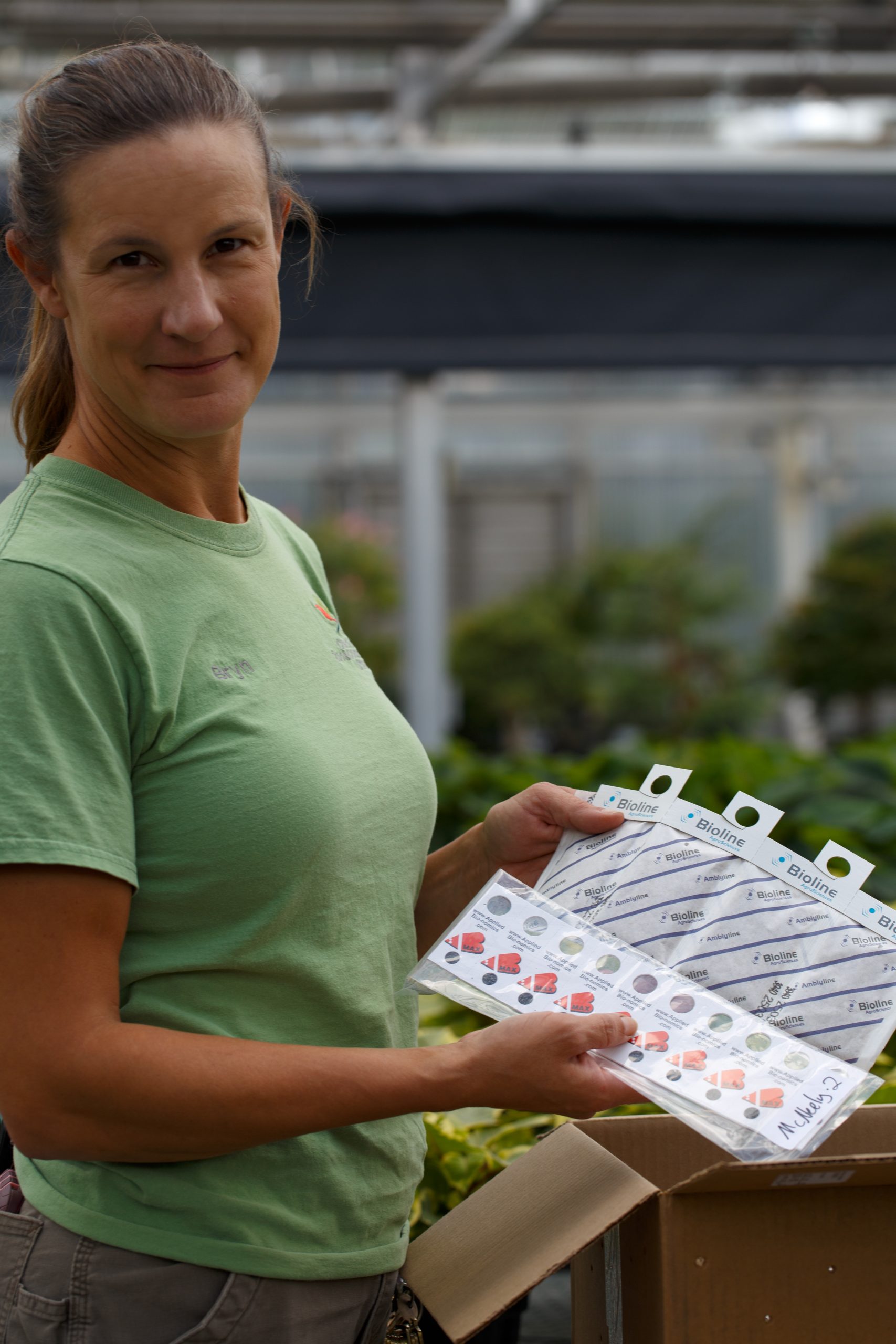
Also known to gardeners as thysanoptera or thunderflies, these needle-thin sucking insects love to feed on mums, causing damage to plants, or worse, transmitting viruses from one plant to the next.
Fortunately, Como’s horticulturists have a tiny but mighty weapon to keep thrips from ruining the show. Known as the cucumeris mite, this half-millimeter predator insect has just been deployed throughout the mum crop destined for the second half of the Fall Flower Show. With an appearance like that of a transparent wood tick, and the ability to prey on thrips and survive on plant pollen, these super small super predators play an important role in the Marjorie McNeely Conservatory’s Integrated Pest Management plan.
“People sometimes think that spraying pesticides is the only way to control pests, but integrated pest management is an approach that combines anything you might do to make a plant healthier, from the condition of the soil it’s growing in, to your nutritional program, to how you’re pruning the plant,” explains Como horticultural supervisor Bryn Fleming. While Como has been a low-pesticide growing facility for decades, Fleming says, “our reliance on beneficial insects has increased more recently,” as the gardening industry embraces more sustainable ways to manage greenhouses and gardens.
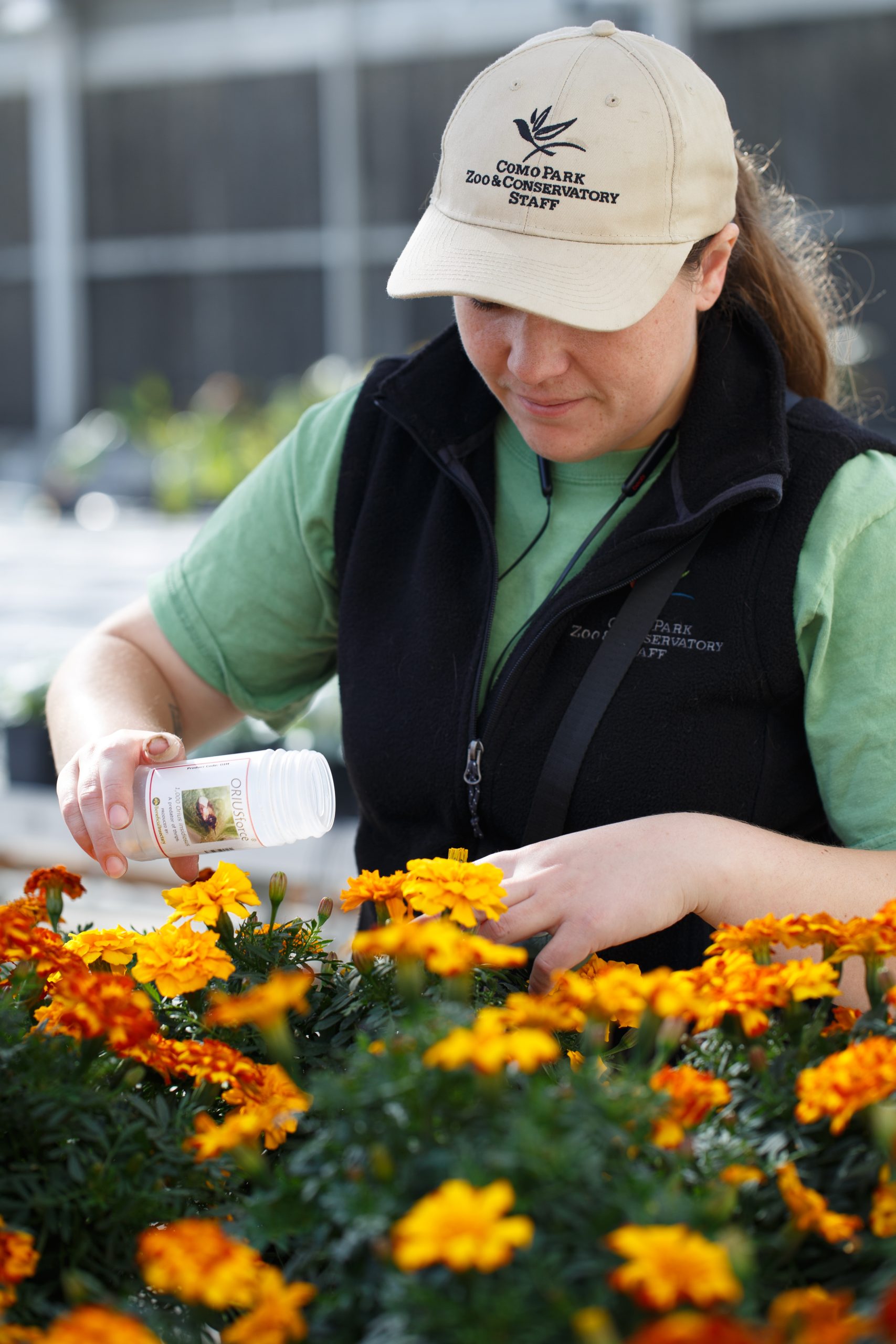
While beneficial bugs show great promise in cutting the use of pesticides, monitoring how well predator insects perform can be time consuming and complex. What’s the right dosage of beneficial insects for a particular plant or crop? How do shifts in such inputs as light, water or temperature affect the efficacy of beneficial bugs? Are some pest predators better than others?
To help answer those questions, the Marjorie McNeely Conservatory is now equipped with a new integrated pest management scouting system called IPM Scoutek. Made possible by your support for Como Friends, this new digital technology tracked on a tablet allows horticulturists to collect data from greenhouses and gardens to make even more informed decisions about how to care for crops and manage pests.
“This technology is used by large-scale growers who are producing bigger agricultural crops, but is also used for nursery or floriculture production.” says Horticulturist Jen Love, who recently shared news about Como’s software scouting system during an American Public Gardens Association symposium at the Franklin Park Conservatory and Botanical Gardens in Columbus, Ohio. “As far as we know, as a public garden the Marjorie McNeely Conservatory is an early adopter trying this approach, and there’s a lot of interest from other institutions in seeing how this process works. If it’s successful, it’s a model we can share with other botanical gardens.”

As Como’s horticulturists discover what digital technology can do for pest management, Fleming says the Conservatory’s early adopters are already impressed by what they’ve seen. “I think this software is going to help us to keep track of things at a much closer level, so when problems come up we can respond to them even sooner,” she says. “To care for a living collection requires constant adaptation, and this technology will help us be a little more proactive than reactive.”
By removing economic barriers to career-building experiences, Como’s new apprentice program is working to build a more diverse future workforce
For the last year, college junior Joshua Lee has been trying his hand at a variety of zookeeping jobs at Como, from caring for the zebras in the hoofstock building, to climbing in with the penguins to take a crack at cleaning the rock work.
“That’s not easy,” Lee admits. “When the penguins are nesting, they’re very protective of their space.”
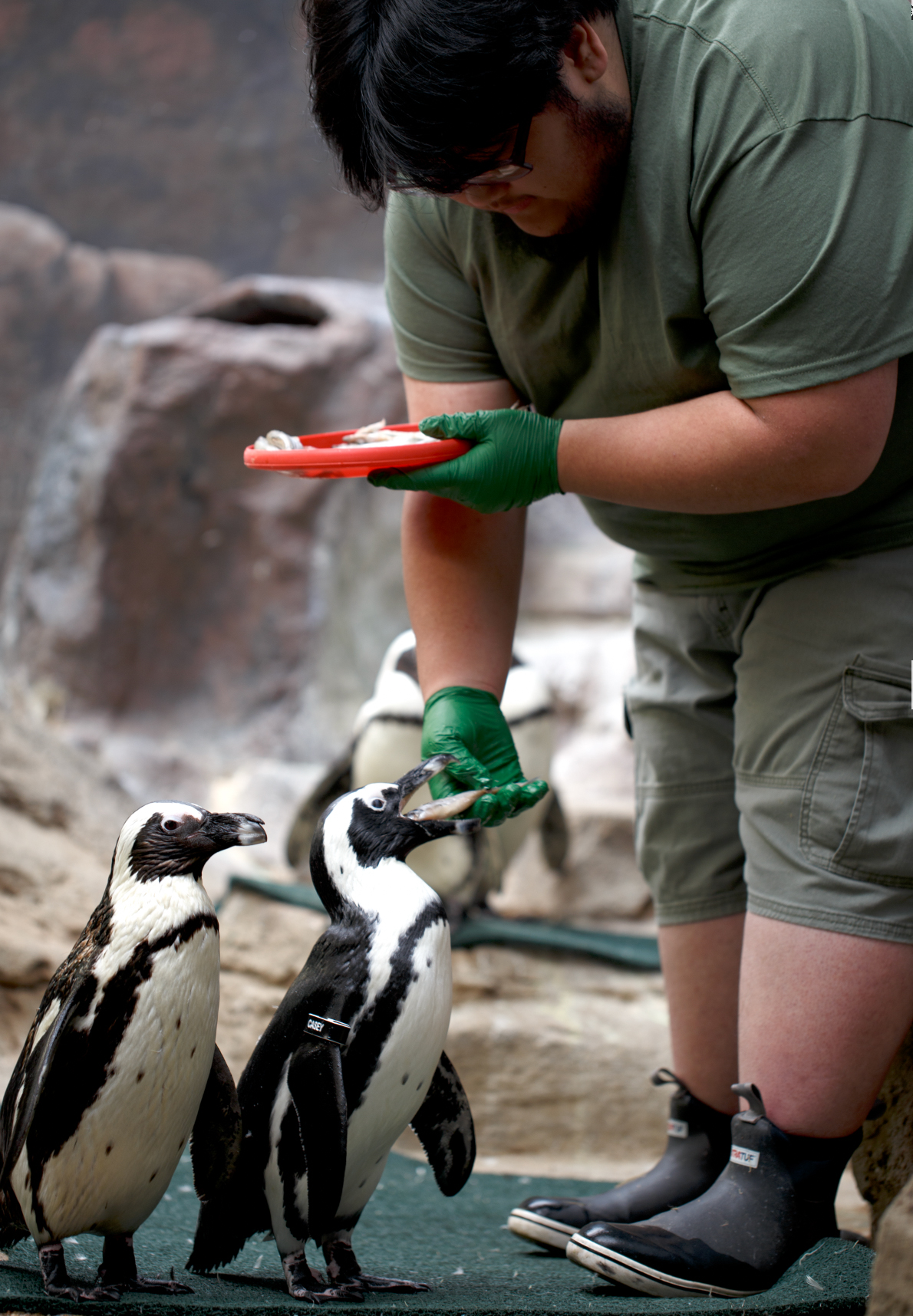
As Lee returns to college for his senior year, he says his experience at Como has given him many new options to consider. “I still don’t know what I will want to do after I graduate, but what I liked about zookeeping was that every day was a different day, and I had a chance to work with so many different animals,” he says.
A zoology major at Minnesota State University, Mankato, Lee is curious about the career paths available to him in animal care. Getting the chance to see the inner workings at a zoo has historically required signing on as a volunteer or an unpaid intern—a traditional career path that can be a major barrier to young people who can’t afford to take time away from paid employment. But over the last year, Lee has been earning money and learning about his future options as part of Como Park Zoo & Conservatory’s new paid apprentice program through the City of St. Paul’s Right Track program.
Mayor Melvin Carter’s youth employment initiative, Right Track engages nearly 1,000 young people from cost-burdened homes throughout Saint Paul in a variety of internships. Launched in 2014 through a partnership between the City of Saint Paul, the Saint Paul Public Schools and the Saint Paul Area Chamber of Commerce, the program’s goal is to establish a pipeline of career development opportunities for Saint Paul youth.
Como’s campus managers helped launch the program at Como in 2022, but the program has been in the works for several years, creating a new, fully paid pipeline for young people who are interested in zookeeping and animal management careers. “The program is also designed to ensure that youth don’t have to work multiple jobs to take advantage of an internship opportunity,” says Lianna Sanders, the Como project manager who oversees the Right Track apprentices. “During the school year, they work 20 hours a week, and during the summer months it’s a full-time job for these apprentices, who also take part in professional development training that’s part of the program.”
Right Track operates out of the City of Saint Paul Department of Parks and Recreation, building on the department’s long history of providing youth development and employment opportunities for Saint Paul youth. While Right Track apprentices at Como are paid minimum wage, a partnership with Como Friends also helps to pay for the gear that apprentices need to be successful on the job, like uniforms and sturdy boots.
“Como’s audience is incredibly diverse, and it’s important to be recruiting a workforce that reflects the surrounding community,” says Como Friends president Jackie Sticha. This summer, Como will say goodbye to Joshua who completed the program this year and Gil and Gabby will stay on and continue with their work here as Como welcomes additional Right Track apprentices for roles in both animal and plant care at Como Zoo and the Marjorie McNeely Conservatory.
As Lee returns to college for his senior year, he says his experience at Como has given him many new options to consider. “I still don’t know what I will want to do after I graduate, but what I liked about zookeeping was that every day was a different day, and I had a chance to work with so many different animals,” he says.
To learn more about the Right Track program, visit here.

